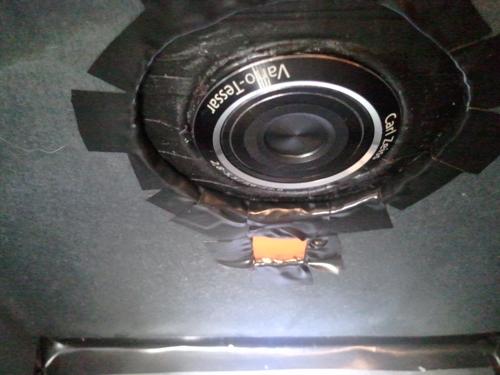15-862 Computational Photography Project 4: Camera Obscura
Hugh Cover and Justin Haines
20 October 2011
Section 1: Construction
The inside of our camera obscura showing the image plane and black lining.

The front face of the camera with a opening for the aperature and camera lens.

The inside of the camera showing the lens of the digital camera mounted in the camera. We constructed a seal out of a sheet of electrical tape that fits tightly around the lens of the digital camera.

The finished camera from the outside.

Section 2: Image Plane Material
We originally used a sheet of glossy photo paper for the image plane which resulted in a spectral reflection as seen in the left image. This artifact occurs because of the non-lambertian nature of the paper. Light entering the aperature at a specific angle is reflected directly into the lens of the digital camera resulting in a bright spot in the image. To correct this problem we replaced the glossy image plane with a sheet of matte paper. This resulted in the image shown on the right.


Section 3: Aperature Size Experiments
These three photos of the CIC were taken with 0.5mm, 1.5mm and 3.0mm aperatures, respectively.



These three photos of the Gates Center were taken with 0.5mm, 1.5mm and 3.0mm aperatures, respectively.



The images captured with the 0.5mm aperature were taken with a ISO setting of 3200 (very high) resulting in a noisy image. This setting was necessary to capture a sufficient amount of light at the maximum exposure time of 30 seconds. The larger two aperature sizes resulted in more blurring with less noise. Due to the low-light conditions we decided that the 3.0mm aperature produced the best results.
Section 4: Extra Photos
A photo of Hugh taken during a brief window of sun in front of Smith hall.

A photo of the Eiffel Tower taken on a sunny day in Paris*.

A photo of the Colosseum in Rome*.

We nearly captured a photo of a Velociraptor*, but it would not hold still long enough.

*Image of an image projected on a screen in a dark room.















